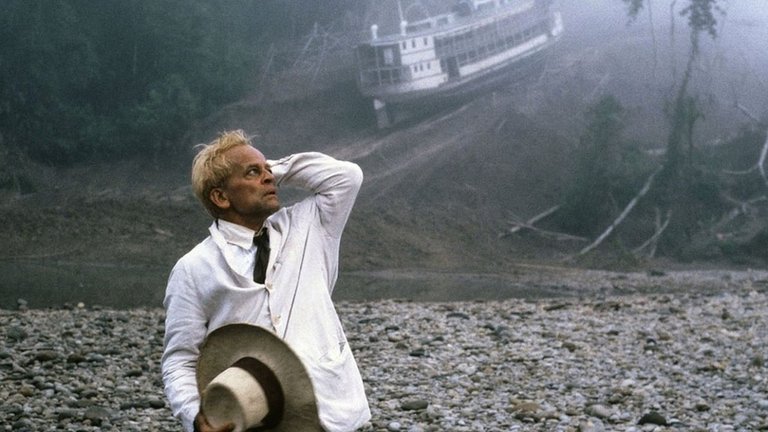Film Review: Fitzcarraldo (1982)

When people talk about "epic films", they usually refer to spectacular Hollywood productions. It is very rare for non-Hollywood films to be seen as "epic", and even rarer for films that could be described as "anti-Hollywood" because of the lack of commercial considerations by their makers. Werner Herzog achieved that with his 1982 adventure epic Fitzcarraldo, film also known as "epic" because of its legendary difficult and seemingly impossible production.
The plot is based on the real life events related to Carlos Fitzcarrald, Irish Peruvian entrepreneur who was one of the leading figures of the Amazon rubber boom in late 19th Century. His fictional counterpart, played by Klaus Kinski, is Brian Sweeney Fitzgerald, known as Don Fitzcarraldo to the inhabitants of Iquitos, small town east of Andes in the Peruvian part of Amazon basin. Fitzcarraldo is great fan of opera and he dreams of building an opera house in the middle of the jungle. His first attempt to raise money for such effort – construction of Trans-Andean railway, failed, so he tries to enter into the rubber trade. He leases the only unclaimed part of land containing rubber trees, which is situated upstream of Ucayali River, area inaccessible to the Amazon because of the strong rapids. Fitzcarraldo notices that the Ucayali is separated by few hundred meters of land from Pachitea River, which is accessible. With the help of Molly (played by Claudia Cardinale), local madam and his girlfriend, as well as sympathetic rubber baron Don Aquilino (played by José Lewgoy), he purchases old steamship and starts expedition on Pachitea in order to explore the isthmus. As he approaches destination, it becomes apparent that the area is still unexplored and inhabited by indigenous tribes hostile to strangers. Fitzcarraldo is nevertheless determined to continue and he wins over the natives by using phonograph with Enrico Caruso's recordings and playing to their myths of "white god". After arriving at the destination he begins the most dangerous and difficult part of the expedition – carrying entire steamship over the hill to the other side and Ucayali River.
The most iconic image of Fitzcarraldo - huge ship being transported over the hill – is the monument to one of the greatest megalomaniacs in the history of cinema. Today, Werner Herzog would easily reconstruct this historic event with the help of CGI, and even in early 1980s special effects could have made shooting of this scene relatively cheap, fast and simple. Herzog, however, had other ideas and, in many ways mimicking the craziness of his protagonist, decided not only to shoot the scene as realistically possible, but also to stray from the historical record for the sake of spectacle. Unlike Fitzcarrald, who had 30 tones ship disassembled and carried to the other side of hill to be re-assembled, Herzog used ten times larger ship and had it carried over the hill in one piece. He used elaborate systems of logs, rails and pulleys and labour force consisting of thousands of native extras. This led to months of hard, difficult labour during which many native workers suffered under difficult conditions and some actually died. Cast and crew also suffered, with Klaus Kinski, infamous for his violent on-set antics, constantly clashing with Herzog. The difficult production, which would make Coppola's Apocalypse Now look like a walk in the park in comparison, became the subject of renowned "making of" documentary Burden of Dreams by Les Blank.
In the end, all troubles didn't prevent Herzog from delivering a truly remarkable film. He had invested of talent and sometimes even risked his own life to create series of memorable images. Fitzcarraldo features memorable scenes that contrast wild, untamed nature of the Amazon with almost fairytale world of civilisation and high culture embodied in opera. And Klaus Kinski, despite his reputation of the madman and countless roles of sinister villains here plays arguably the most likeable character of his career. Fitzcarraldo is presented as madman, but a charming madman whose impossible dream of bringing opera to the middle of nowhere looks harmless and creates a lot of sympathies. He charms his girlfriend, played by one of the greatest divas of world cinema; he charms local children; he charms otherwise shrewd and greedy capitalist; he charms previously sceptical members of the ship's crew into following his scheme to its end; and, finally, he charms even the natives who much more experienced Franciscan missionaries failed to reach. Just like Herzog, character of Fitzcarraldo suffers setbacks and experiences problem, but in the ened he is rewarded by seeing his dream becoming reality in one of the most surreal, but also the most moving scenes in the history of cinema. Fitzcarraldo thus became one of the most uplifting films in Herzog's career and one of the rare pieces of the filmography that would bring smile to audience's faces. Although it isn't perfect, with few scenes being overlong and Popol Vuh's soundtrack being at odds with classic operas, Fitzcarraldo justifies its reputation of the film which is epic in more ways than one.
RATING: 8/10 (+++)
Blog in Croatian https://draxblog.com
Blog in English https://draxreview.wordpress.com/
Leofinance blog https://leofinance.io/@drax.leo
Cent profile https://beta.cent.co/@drax
Minds profile https://www.minds.com/drax_rp_nc
Uptrennd profile https://www.uptrennd.com/user/MTYzNA
Hiveonboard: https://hiveonboard.com?ref=drax
Rising Star game: https://www.risingstargame.com?referrer=drax
1Inch: https://1inch.exchange/#/r/0x83823d8CCB74F828148258BB4457642124b1328e
BTC donations: 1EWxiMiP6iiG9rger3NuUSd6HByaxQWafG
ETH donations: 0xB305F144323b99e6f8b1d66f5D7DE78B498C32A7

What an unbelievable film this was! Although Kinski and Herzog hated each other, they knew about the genius of the other!